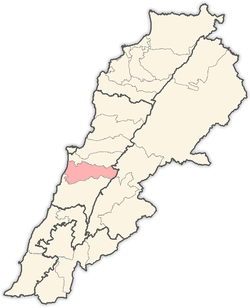Shemlan
| Shemlan شملان Chemlane | |
|---|---|
 | |
 Shemlan Location in Lebanon | |
| Coordinates: 33°47′N 35°33′E / 33.783°N 35.550°E | |
| Country |
|
| Governorate | Mount Lebanon Governorate |
| District | Aley District |
| Time zone | EET (UTC+2) |
| • Summer (DST) | +3 (UTC) |
Shemlan (also spelled Chemlane, Chimlane, Shimlan) is a village in the Aley District of the Mount Lebanon Governorate in Lebanon, located about 25 km from Beirut.[1]
History
Shemlan is first mentioned in chronicles as early as the 12th century. More recent accounts attribute Shemlan as being part of the land belonging to the Shehab Family. In the 19th century, this land was donated to the Antonine Monks. Over the years, Shemlan was inhabited by a number of well-entrenched families, including the Jabbour's, Hitti's, Moukaddem's, Tabib's and Farajallah's many of whom emigrated during the 1975 – 1990 civil war.
Shemlan's strategic location overlooking Beirut International Airport and its diverse political make-up made Shemlan a fierce battleground during the 1958 civil war and the Israeli invasion of Lebanon.
In 1948, the British Government opened the Middle East Centre for Arab Studies (MECAS) in Shemlan. This school gained a reputation as being a "spy school" because of allegations, made by Lebanese politician Kamal Jumblatt, that many of its graduates worked for the C.I.A. or Britain's Foreign Office. However, the only proven case of a spy studying at MECAS was that of British/Soviet double agent George Blake,[2] who was escorted from MECAS and formally arrested at Heathrow airport.
Notable citizens
Philip Khuri Hitti (1886-1978), a renowned Lebanese American author and professor on the Middle East, is Shemlan's most famous resident. He was born in the village into a Maronite Christian family.
References
- ↑ 1
- ↑ Fisk, Robert (2001-01-01). Pity the Nation: Lebanon at War. Oxford University Press. ISBN 9780192801302.
External links
Coordinates: 33°47′N 35°33′E / 33.783°N 35.550°E
